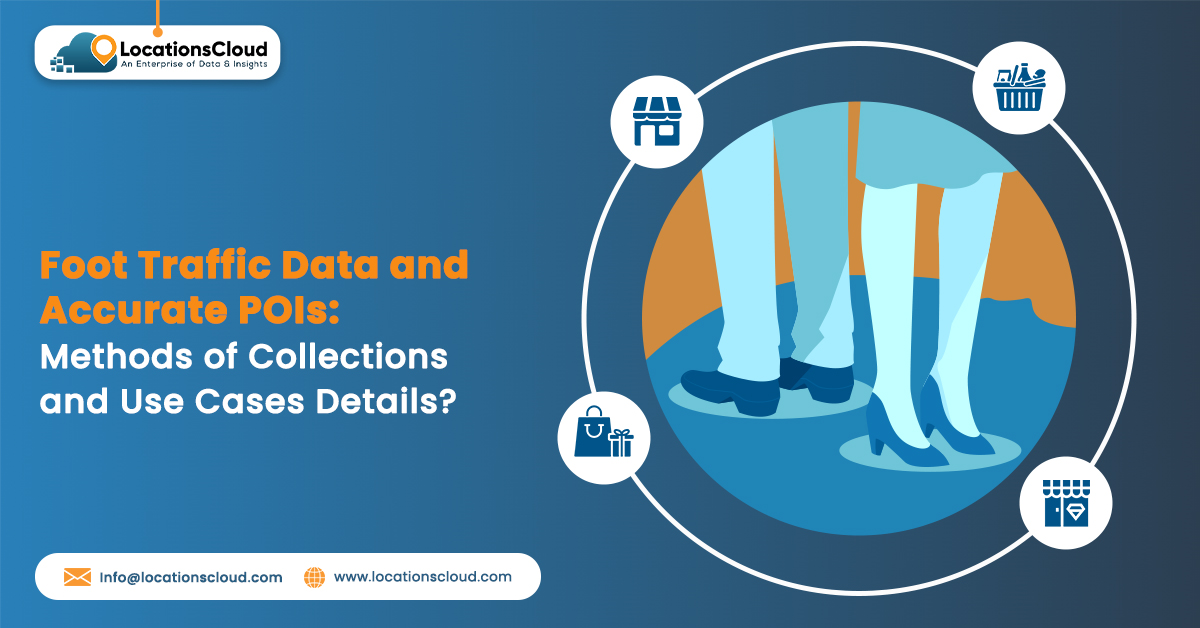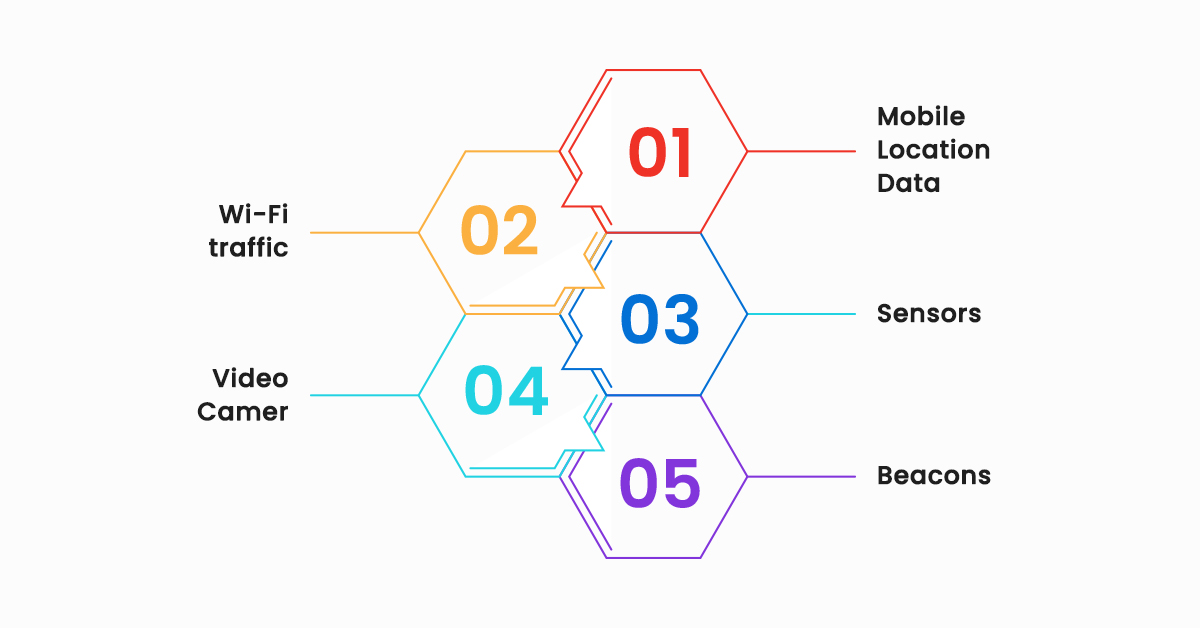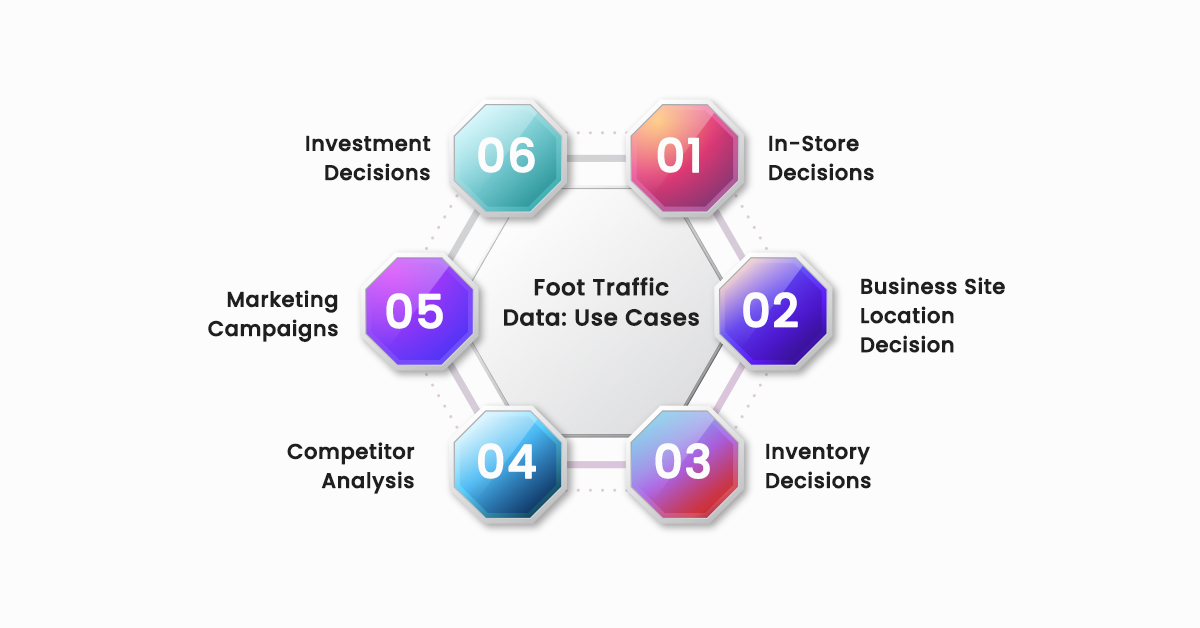
Foot traffic analysis determines the revenue for retail businesses like hypermarkets, departmental stores, malls, restaurants, grocery stores, gift shops, jewelry stores, etc. For these businesses, foot traffic is the lifeline. Foot traffic data suggests how popular a place is and whether the area is profitable to open a new business site or not. Foot traffic data can help businesses make strategic decisions like finalizing business locations, or investments, or tactical decisions like determining requirements for staff or inventory levels.
If you want to do competitor analysis or want to find a suitable location for your new business site, you need to collect foot traffic data. This will include specific data related to points of interest (POIs).
This article details what foot traffic data is, how to get foot traffic data for POIs, and what are the use cases of foot traffic data.
What is Foot Traffic Data?
In retail settings, the number of visitors, shoppers, and potential customers entering the premises of a store branch location are termed as foot traffic or footfalls. The foot traffic can be counted as per day, per week, per month, per quarter, or even per hour. The data is the source of knowing the busy times, peak times, leisure times, less crowded times, etc. This data can be used to schedule staff timings (more staff at peak times) and less at leisure time. Also, store owners can plan to launch their new offers or products when there are more customers in their stores.
For instance, suppose a mall located in Area A receives 3K foot traffic every day and another mall located in Area B receives 1k footfall every day, then businesses looking to open another mall or similar business will prefer Area A as it is more likely to get foot traffic than Area B. Also, if anyone wants to invest in the mall, they will prefer the mall located in Area A. Of course, there are other permutations and combinations too. If Mall B is located in a premium area and though has only 1K visitors, their average ticket value is 4X more than those in Mall A, then Mall B can be a better investment opportunity. This means foot traffic has to be analyzed with other metadata and business metrics to finally arrive at a decision.
Still, for similar types of businesses foot traffic is a data mine that if explored properly, can be highly beneficial. For instance, if there are two grocery stores located in the same area and you want to know which grocery store will be a better investment, then foot traffic is the key.
Foot Traffic Data Reveals the below information/variables over a defined period:
- How many visitors a store location or business premise such as a restaurant gets on a daily, weekly, monthly, or yearly basis?
- What is the average time the visitors stay at the location?
- Visitors who walk past the premises but do not enter the establishment
- The time at which most visits happen
- Less crowded time
- Which parts of the store, departments, aisle, or counters are the most visited (specific points of interest)?
- High-priority areas or completely neglected areas of the store
Accurate POIs in Foot Traffic Data
Accurate Points of Interest (POI) foot traffic data is crucial data analysis in retail environments.
POIs are specific locations or areas within a store that are of interest for various reasons, such as high-traffic areas, product displays, checkout counters, or promotional sections.
Accurate POI data helps identify where shoppers spend most of their time. Accurate POI data provides key performance indicators (KPIs) such as foot traffic counts, average dwell time, and conversion rates for specific areas within the store.
Mobile devices working in a particular location at a given time, or mobiles connected to Wi-Fi provided free by the establishment are important sources of POIs for foot traffic data. Sensors, manual entry registers, POS billings, counter entries, etc. are more sources of foot traffic. However, their accuracy levels do not match up to those offered by mobile connections in a vicinity. GPS data shows where people are going and how long they stay, but the real value comes from understanding what’s at those locations.
Top 5 Ways to Collect Foot Traffic Data of Points of Interest

Mobile Location Data
Today almost all customers carry their smartphones wherever they go. These mobiles have location tracking systems enabled through GPS or beacons. Those who have given location permission to Google or Apple and have downloaded the store’s app can be tracked via a mobility data tracker. However, if the location data is disabled, then it is difficult to track such visitors.
Social Engagement
When people use social media at a store or restaurant, they often: “Check in” to show they’re there or mention the place in their posts along with its review. This way they tag the location in their photos or updates. By tracking this social media activity, businesses can learn how many people visit their store, when people tend to see the most, and what customers think about their experience.
Geofencing
Geo-fencing tech detects customers with your app as they enter this virtual zone. Monitor shopper movements, time spent, and visit regularity. Examine data to identify busy periods, hotspots, and consumer habits.
Marketing Event
Businesses can organize a marketing campaign (an in-store event) offering discounts, coupons, gift vouchers, and other benefits for in-store customers. This data can reveal marketing hotspots and how the foot traffic interacted with the event. The event can help collect relevant data about foot traffic (customer demographics, interests, and offer inclinations). Analyzing the performance of location-based marketing campaigns, such as targeted ads or promotions, can indirectly indicate foot traffic trends and the effectiveness of efforts to drive in-store visits.
Beacons
Beacons provide precise data on customer visits and movement patterns, helping retailers understand which areas of the store are most popular. However, for beacons to work effectively, customers need to have Bluetooth enabled on their devices and the store’s app installed. This may limit the data collected to only a subset of customers.
Other Methods:
- POS Data Analysis: By analyzing Point of Sale (POS) data, businesses can estimate foot traffic based on sales transactions. While POS data won’t reveal the number of visitors as there may be more people along with the one who does the final billing payment, it provides insights into peak shopping times. POS data is time-stamped.
- RFID Tracking: Radio-frequency identification (RFID) tags on products and shopping carts track movement within a store.
- GeoFencing: Geofencing involves setting up virtual boundaries around a physical location using GPS or RFID technology. When a customer’s mobile device enters or exits these boundaries, the geofence triggers an action such as sending a push notification or logging the visit.
- Pressure Mats: Pressure mats have thermal sensors that are triggered by weight. Customers stepping on these mats are tracked.
Foot Traffic Data Providers extract the footfall data from various sources and provide the same in anonymized form. This helps protect customer privacy and serves the purpose. Data privacy laws across the USA, European Countries, and the UK are stricter and do not spare those who reveal personal data of customers without permission. This means anonymized data is safer to play with. The POI foot traffic data providers maintain accuracy in counting the foot traffic but will anonymize it for info such as demographics, names, ages, etc.
Use Cases of Foot Traffic Data Analysis

In-Store Decisions
Foot traffic Analysis data is pivotal in decision-making related to retail businesses. When coupled with other data sets like sales data, POS data, CRM data, and more, foot traffic data can assist businesses in planning inventory, optimizing store layouts, and ensuring adequate in-store staff. For instance, if foot traffic is more between 6 p.m to 8 p.m. then, store managers can employ more people as part-time employees between that time.
Business Site Location Decision
It is prudent to have your business location at a place where there is a significant footfall. While footfall trends may change over time and are subject to development in the areas initially when you want to choose an area as your store site location, consider foot traffic in the area for other stores, competitor stores, etc. Your product success will depend much on foot traffic trends and the visitation of customers. Couple the foot traffic area with other parameters like upcoming road connectivity projects, new projects in the area, residential building plans, etc to make a sound decision.
Inventory Decisions
The higher the consumer foot traffic data, the greater the need for inventory supply. Consistent footfalls over time and increasing sales figures along with foot traffic are indications to plan your supply chain. Optimize inventory as per indications visible in foot traffic data.
Competitor Analysis
By comparing foot traffic patterns at your store with those at competitors’ locations, you can gain valuable insights into market trends and customer preferences. Analyze consumer foot traffic data to spot trends and patterns in customer behavior at competitor locations.
Marketing Campaigns
Use foot traffic data to identify peak shopping times and target customers with promotions during these periods. For instance, if foot traffic is highest during weekends, launch special weekend deals to maximize customer engagement. Measure the impact of marketing campaigns on foot traffic. If a campaign leads to a noticeable increase in foot traffic, it indicates its success. Plan in-store events or promotions around times of high foot traffic to maximize attendance and engagement.
Investment Decisions
Properties in high foot traffic areas generally have higher values. Foot traffic data can be used to justify the pricing of real estate. Investors can use historical foot traffic trends to forecast revenue and make informed decisions about where to allocate capital. Investors can compare foot traffic data across multiple locations to identify the most promising investment opportunities
Privacy Considerations and Ethical Data Collection
Legally, consumer foot traffic data is sensitive information containing consumer data. How this data is collected, utilized, and shared attracts federal law regulations and scrutiny. If you are using channels that authorize permissions from customers to collect the data then you are safe. For instance, billing data, consumer loyalty card data, memberships, etc. are ethical and legal ways to collect foot traffic data. Anyways, even if you are collecting via mobile devices, cameras, or GPS, then make sure the data is masked and anonymized.
The data should only used for a number purpose. For example, how many visitors came inside the store can be collected but who were they and other personal details must be avoided. If you hire a foot traffic data provider, make sure they adhere to privacy laws like GDPR, CCPA, and other local laws.
Conclusion
The article details how to find foot traffic data for various use cases. Mobile location tracking, Wi-Fi traffic analysis, sensors, video cameras, and beacons are some of the top methods for collecting foot traffic data.
However, it is crucial to collect and use foot traffic data ethically and legally. Businesses must work with foot traffic data providers who comply with laws like GDPR and CCPA to maintain trust and avoid legal repercussions. Reputed footfall data providers like LocationsCloud ensure data is anonymized to protect consumer privacy.


